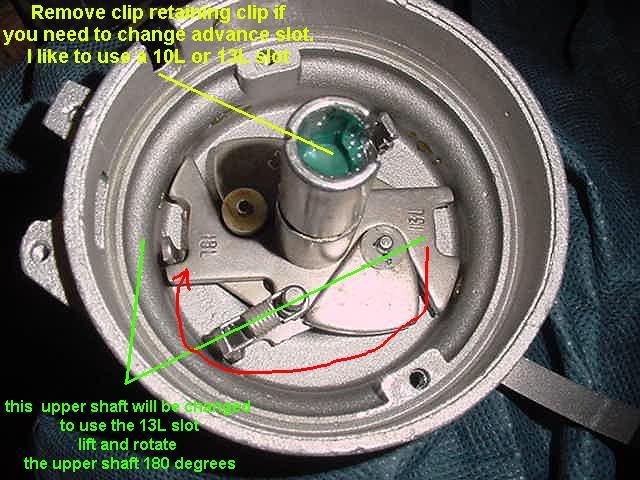So...I found NAPA part number
NRD 482808 on their site - that looks to be the right one for this application. If you guys can find an old swap meet junker for trading stock, you might save some of the $33 core value so he can keep his original.

Before you put the new one in - you might find it convenient to have a look at the mechanical advance mechanism while it is out on the bench. The above photo shows the typical Ford flyweight arrangement used on the later distributors. It isn't too difficult to disassemble one down to this level. The pictured unit has two "total advance" limits to choose from....18L and 13L. When the base is engaged in the 18L slot - the distributor can provide 18° of advance (36° at the crank). When it is engaged with the 13L slot - 13° (26° crank). You would like to find it in the 13L slot and if not, its a good idea to put it there. To move one 180° you must remove the little retaining clip (located under the green grease in the picture), disconnect the springs, and lift the upper rotor shaft up to turn it. The little clip has two upward facing whiskers - they have to be spread not squeezed. There is a variation of this pictured rotor shaft that has a 15L and a 10L slot - if that is what you find, I'd say use the 10L. It could be opened to the same length as a 13L with a small rat-tail file - but that is getting ahead....
Here is why you want the limited distributor advance setting - the engine will only tolerate something like 36°-38° of total mechanical advance (that is the initial plus the distributor) under load (with low/no manifold vacuum). You want to put more initial on the bottom (10°-12°) without violating the upper limit. If you were to use the 18L slot - then the initial advance set point would have to be down at 0°-2°. When using the 13L slot, the initial can be 10°-12° (adding some nice low end torque) and not violate the advance limit as the engine gets into the higher rev's.
Installing it - the lower end has a hex drive for the oil pump shaft. In some instances, where these shafts don't get a lot of engagement into the distributor - you have to be darn sure the new distirbutor is fully down into the engine well and engaged - or you'll soon be trying to start up with no oil pressure! Rotation is counterclockwise as seen from above.

Steve Metzger Tucson, Arizona